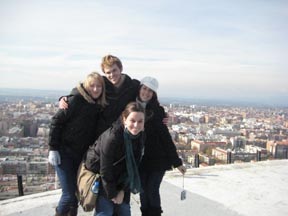A deeper look at Madrid
 Madrid is one of the most happening cities on Earth when it comes to nightlife. It has more bars per capita than any European city, with plenty of clubs, late-night munchies spots, and a vibe that satisfies all ages. Take for example the seven story Kapital club, which plays a different genre on each floor, accompanying a gigantic rocket engine that intermittently blasts sweaty dancers with mist on the main dance floor. Madrid’s Joy Eslava, and many others, make it easy for students to get in free. All in all, Madrid clubs are unlike any clubs I’ve experienced in Seattle or San Francisco, and prices are reasonable if you do not plan on buying a drink. Also noteworthy to mention was the very efficient, economical Madrid Metro, which I used all the time.
Madrid is one of the most happening cities on Earth when it comes to nightlife. It has more bars per capita than any European city, with plenty of clubs, late-night munchies spots, and a vibe that satisfies all ages. Take for example the seven story Kapital club, which plays a different genre on each floor, accompanying a gigantic rocket engine that intermittently blasts sweaty dancers with mist on the main dance floor. Madrid’s Joy Eslava, and many others, make it easy for students to get in free. All in all, Madrid clubs are unlike any clubs I’ve experienced in Seattle or San Francisco, and prices are reasonable if you do not plan on buying a drink. Also noteworthy to mention was the very efficient, economical Madrid Metro, which I used all the time.
 The food opportunities in Madrid are mouth watering. Madrid, although land-locked, has the second highest consumption of seafood in the world, after Japan. It is famous for its Bacalao (cod) tapas, croquettes, and so much more. The La Rioja region in Spain offers exceptional, economical wine and Extremadura to the southwest provides jamoñ ibérico, the finest ham in the world. A typical late night or early morning treat is chocolate con churros (chocolate with churros), which surprisingly hasn’t caught on in the U.S. The truth is that one has to spend a little extra to be able to seek out and experience the truly inventive cuisine Spain has to offer. Within close proximity to San Sabastian and Barcelona, arguably the two most progressive culinary epicenters, Madrid holds its own and delights foodies if they are willing to pay. I only make this point because many of my friends felt that the Madrileño cuisine was not good (fried, nothing too interesting, not lots of options). This is completely false as I witnessed in disbelief many of my friends consistently opting for the cheap food that was boring and unoriginal.
The food opportunities in Madrid are mouth watering. Madrid, although land-locked, has the second highest consumption of seafood in the world, after Japan. It is famous for its Bacalao (cod) tapas, croquettes, and so much more. The La Rioja region in Spain offers exceptional, economical wine and Extremadura to the southwest provides jamoñ ibérico, the finest ham in the world. A typical late night or early morning treat is chocolate con churros (chocolate with churros), which surprisingly hasn’t caught on in the U.S. The truth is that one has to spend a little extra to be able to seek out and experience the truly inventive cuisine Spain has to offer. Within close proximity to San Sabastian and Barcelona, arguably the two most progressive culinary epicenters, Madrid holds its own and delights foodies if they are willing to pay. I only make this point because many of my friends felt that the Madrileño cuisine was not good (fried, nothing too interesting, not lots of options). This is completely false as I witnessed in disbelief many of my friends consistently opting for the cheap food that was boring and unoriginal.
Just as food is critical in getting to know about another culture, so is the opportunity to live with a native speaker. In my case, I lived with a single Argentinean man in his early thirties. This was unlike the housing situations of my friends, who lived with Spaniards. The difference was that Madrileños are concerned with confianza, or trust, and if they wanted to have a friend stay the night, they would have to get permission beforehand. In my case, my Argentinean host was indifferent to who I had over to the house. I found it interesting that most all of the socializing between Spaniards occurs outside on the street, in the cafes, in bars, and the home was mainly used for family and get-togethers with close friends. I lived in a spacious studio apartment, and most all of my fellow CIEE program mates were satisfied with their living situations.
